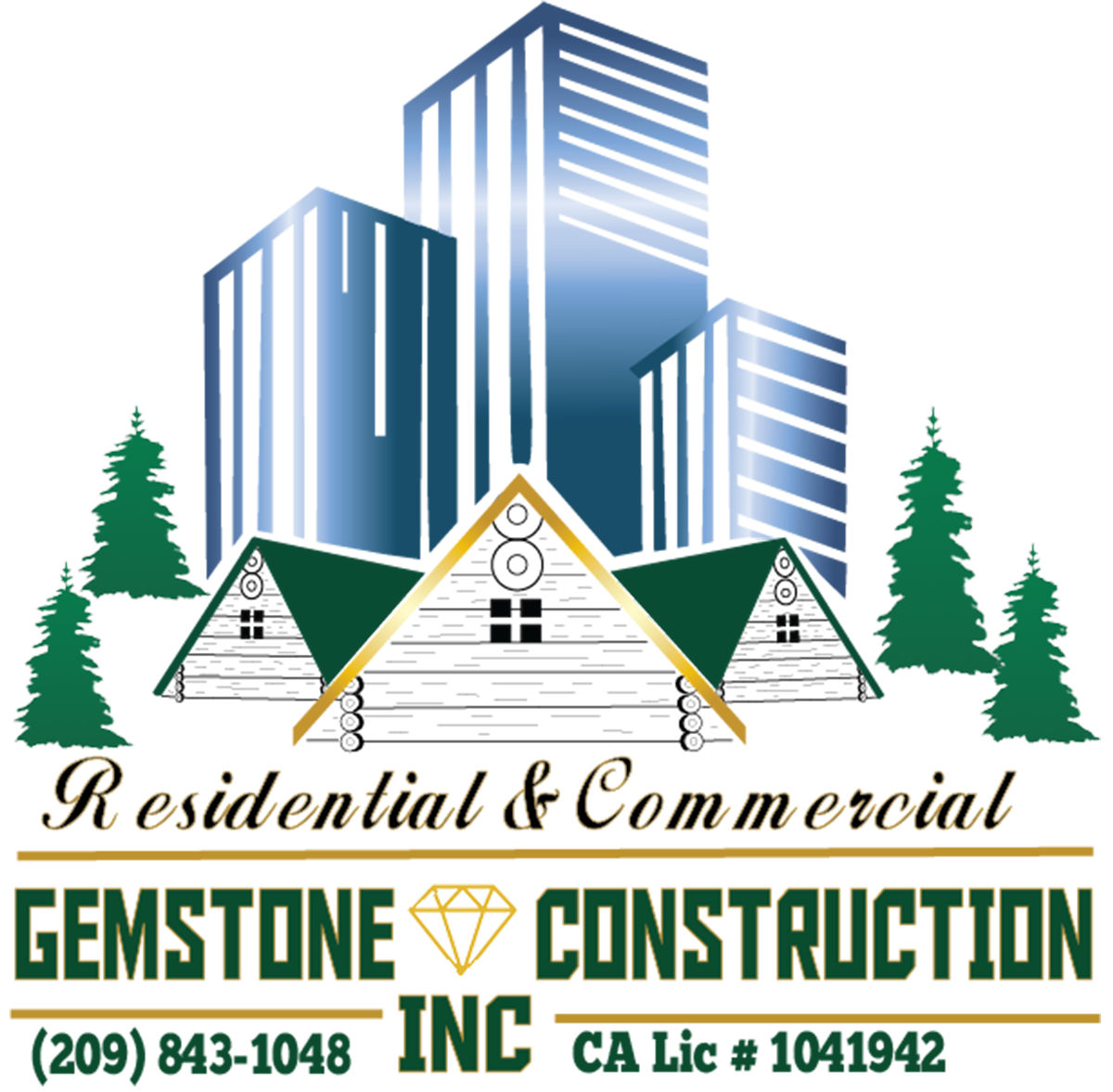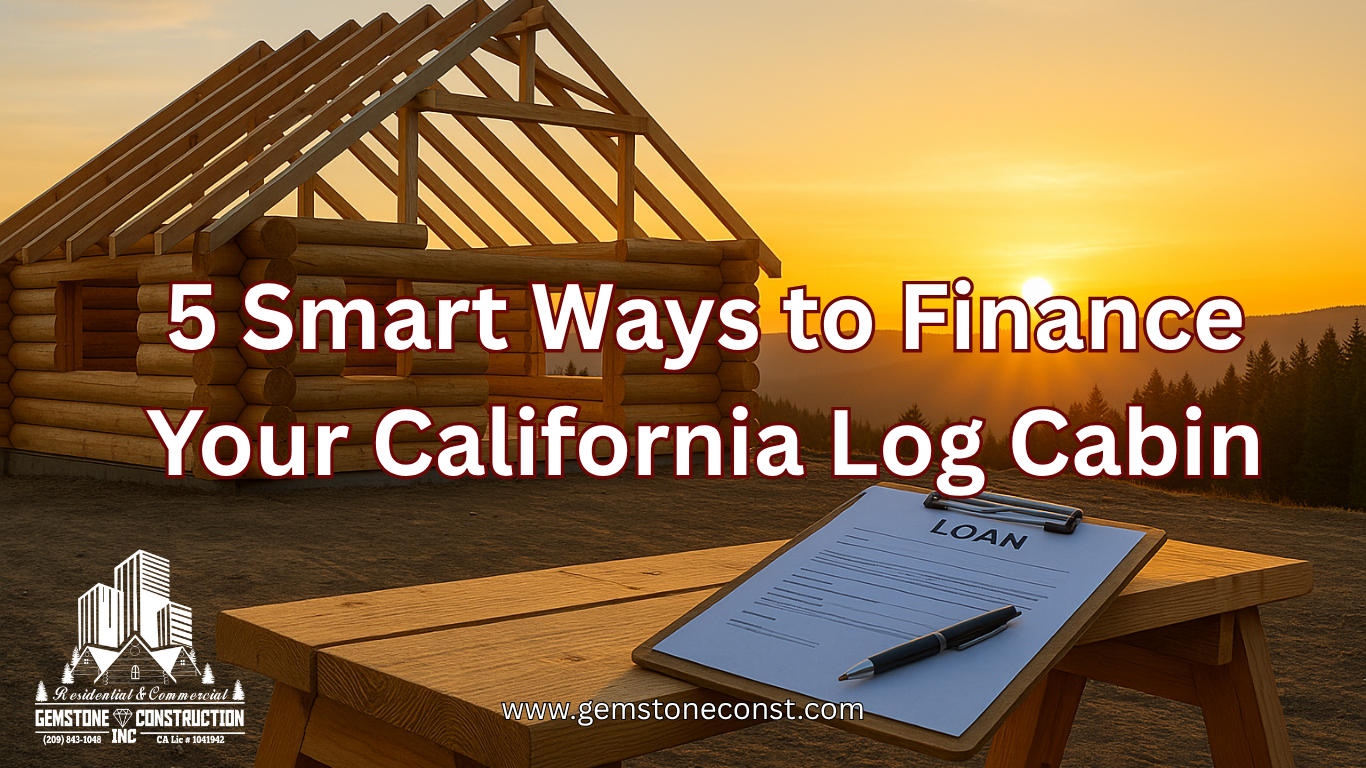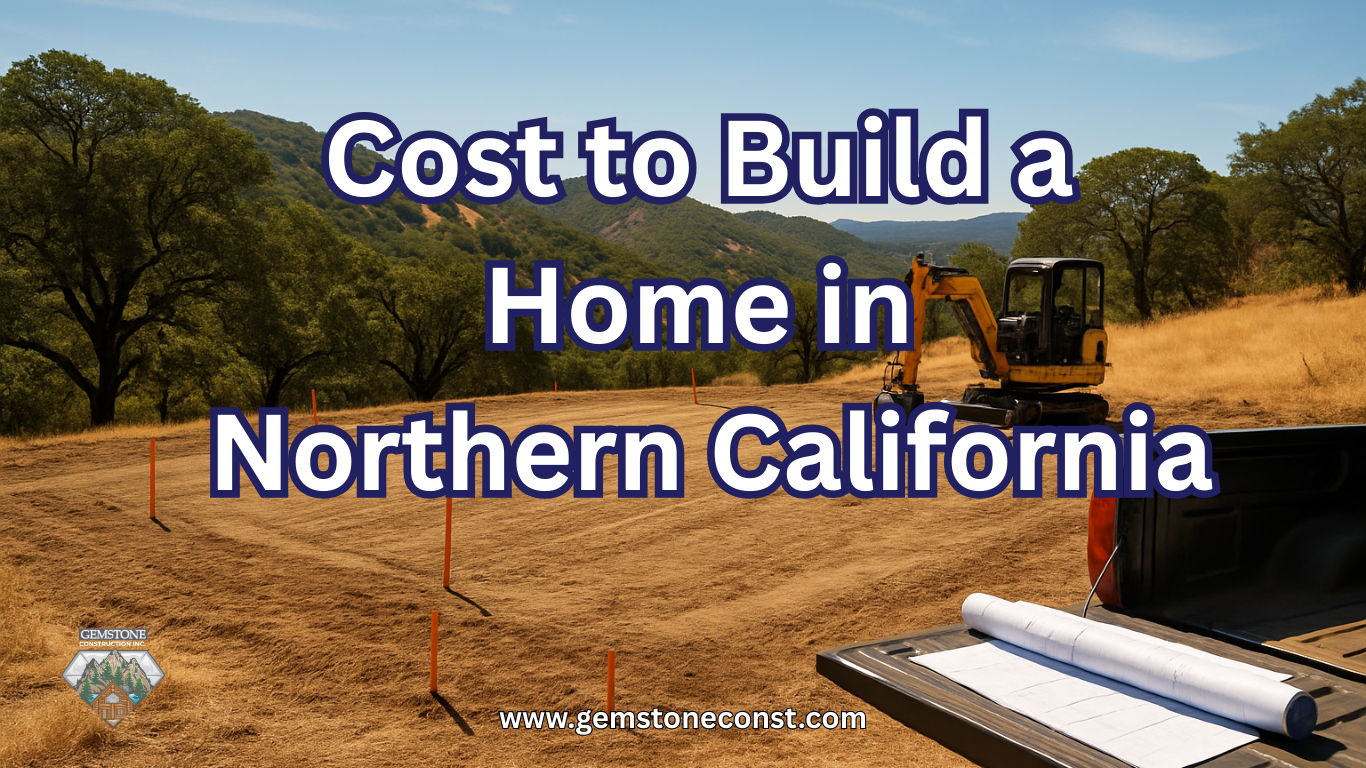GemStone Construction Blog
5 Smart Ways to Finance Your California Log Cabin
June 24, 2025 | Sacramento, CA USA
You’ve pictured the cedar beams, smelled the fresh-cut pine, and even circled a perfect clearing on your parcel map. Now comes the question every future cabin owner Googles first: how do I pay for it? In log home financing California, the rules feel looser than a flannel cuff one minute and tighter than a bank vault the next. Different lenders, county codes, and wildfire add-ons can send quotes zig-zagging like mountain switchbacks. The good news? Buyers who understand the five main funding paths—plus a few bank-friendly tricks—rarely stall out before the slab is poured.
Think of this guide as a road atlas, not a sales pitch. We’ll walk through single-close construction loans, stand-alone build loans, equity taps, government help, and private-portfolio money. Along the way, we’ll drop real-world tips on credit scores, draw schedules, and cost sheets—because those tidy numbers you assembled during design planning are your ticket past the loan officer’s raised brow. By the end, you’ll know which lane fits your budget, your timeline, and the handcrafted dream rising in your head.
Construction-to-Permanent (Single-Close) Loans
The one-and-done close feels almost too easy at first glance. You sit down once, sign a mountain of papers, and walk away with money for land, build, and long-term mortgage bundled under one roof. That single closing cost is the big lure: skip the second round of title fees and appraisal charges you’d face months later with other products. Better yet, the rate converts to a fixed mortgage the day final inspection clears, protecting you if interest numbers climb while you’re picking stain colors. According to the Consumer Financial Protection Bureau, a construction-to-permanent loan “automatically converts to a standard mortgage once the home is finished,” sparing borrowers a second round of closing fees.
Lenders love order, and a single-close loan delivers it in spades. They release money in “draws” after each milestone—foundation, dried-in shell, and final finish—so your builder never gets too far ahead of the bank’s comfort zone. To keep draws flowing, be sure your cost breakdown lists everything from rebar to porch lights. A lean, well-labeled spreadsheet breeds confidence, especially when wildfire-code allowances for Class A roofing or metal vent screens appear as distinct line items.
Draw Schedules & Rate Locks
During the build, monthly payments cover interest only on the cash already drawn. That keeps bills gentle while lumber bills pile high. Still, rate locks deserve a close look. Some banks lock the end-loan rate at closing; others float until the cabin passes its final blower-door test. A locked rate shields you from market spikes, but it usually costs an upfront point. Weigh that fee against the peace of mind of knowing exactly what your 30-year payment will be when you hang your first family photo over the stone hearth.
Inspections show up like clockwork—often every 30 or 45 days. Keep your contractor in sync with the inspector’s calendar, or the crew may sit idle waiting for a signature. When everyone hits their marks, single-close loans move smoother than a freshly planed log and roll effortlessly into a mortgage before your first snowpack settles on the roof.
Stand-Alone Construction Loan Plus Refinance
Think of this as a two-step dance: a 12-month construction line pays the bills while sawdust flies, then a traditional mortgage replaces it after final inspection. Why pick the extra paperwork? Flexibility. Some borrowers land land at auction, draw up floor plans later, and need time to firm up costs before locking 30-year numbers. Others hope mortgage rates will slide during the build and want a chance to pounce if they do.
That freedom, though, comes at a cost—two sets of closing fees, two appraisals, and potential rate risk if the market spikes. California’s jumbo-loan limits hover around $1,089,300 in high-cost counties for 2025. If you top that, your refinance falls into jumbo territory with stricter debt-to-income ratios. A tight footprint and careful material list—the homework you did while comparing floor-plan footprints—keep appraisal surprises to a minimum and give underwriters confidence that your dried-in shell is worth the gamble. That’s why many owners firm up their layout with a detailed floor-plan and cost guide before handing drawings to the bank—the clearer the square footage and room flow, the smoother the appraisal.
Conforming vs. Jumbo Limits in CA
County caps read like Area 51 flight manuals at first, but one rule helps: the denser the zip code, the higher the conforming limit. Rural Plumas County tops out at standard federal ceilings, while Napa flirts with jumbo thresholds even on modest-size cabins. Wildfire surcharges slip into appraisals, too; ignition-resistant soffits and ember-proof vent screens bump replacement value and nudge loan numbers up.
Refinance timing matters: most banks require 20 percent equity at the end of construction to roll the short-term note into a 30-year. If appraised value dips—say lumber prices cool— borrowers must cover the gap with cash. Keep an eye on commodity charts while your logs leave the mill, and update your cost sheet monthly so nothing blindsides you the week rates lock.
Using Your Own Equity: HELOC or Cash-Out Refi
Nothing feels better than making your current house fund your future cabin. A home-equity line of credit (HELOC) taps idle equity and works like a giant credit card: draw what you need, pay interest only, reuse as builds progress. Flexibility is the star here—need five grand for the second lumber drop? Swipe and move on. Rates, however, float. If the Fed nudges numbers skyward halfway through framing, your HELOC payment can jump faster than you can say “pine tongue-and-groove.”
A cash-out refi offers a fixed-rate alternative. You replace your existing mortgage with a larger one, pocketing the difference. The payment bumps up, but you dodge variable-rate drama. Just plan your overlap: two mortgages—one on the old place, one on the new cabin—create a tense few months. Map your construction schedule so the cabin is livable before you list or lease the current house, avoiding double payments and midnight stress.
Overlap Costs & Exit Strategy
Carrying twin loans for even three months can feel like picking up logs without skid tongs—awkward and risky. Many owners structure the build so exterior finish and interior drywall wrap right before the old home hits the market. That way, proceeds retire the HELOC or cash-out boost before interest becomes a budget hog.
Exit plans matter. Will you flip your primary home into a rental? Talk to your CPA about passive-income write-offs before closing the equity loan. Keeping property managers in the loop early prevents vacancy gaps and cushions payments when the first winter heating bill arrives at the cabin.
Government-Backed Help (FHA 203(k), USDA, VA)
Federal alphabet soup can taste sweet when you qualify. FHA 203(k) loans bundle purchase, rehab, and build costs—handy if the property has an old cabin you’ll demo before setting logs. Down payments dip as low as 3.5 percent, but credit-score minimums still hover around 620. USDA Rural loans shine in lightly populated counties, waiving down payments altogether if income fits local caps. VA construction loans serve eligible veterans, offering no-money-down builds with capped closing costs.
Paperwork runs thick. Lenders must approve your builder, and draw inspections follow federal playbooks that feel as long as a Sierra ridgeline. Still, tying septic upgrades, wildfire-mitigation decks, and solar roofs into one low-interest note can free cash for finishing touches like stone chimneys and handcrafted railings. Double-check county maps; some scenic lake districts sit outside USDA zones even though they feel remote.
Portfolio & Private Lenders for Unique Builds
When your cabin plans include a two-story great room, carved spruce columns, and a cantilevered glass deck, mainstream banks may blink hard. That’s where portfolio lenders step in. Local credit unions, regional banks, and private investment groups keep loans in-house rather than selling them to Fannie or Freddie. Their underwriters understand that handcrafted logs don’t fit cookie-cutter comps, so they lean on builder reputation and detailed schedules instead of generic square-foot tables.
Expect larger down payments—often 25 percent—and higher interest during construction. But approvals come quick when you arrive with licensed GC contracts, a line-item budget showing wildfire code add-ons, and a timeline that proves you’ve read the build-timeline guide. Private lenders especially love seeing contingency buffers and proof you priced crane rentals for ridge deliveries; those little details shout “low risk” louder than any credit score.
Build a Winning Loan Package
Start with a one-page summary: land address, square footage, footprint shape, and total cost broken into land, labor, materials, and soft costs. Attach your builder’s license, proof of insurance, and a Gantt chart sketched in plain English. Round things off with wildfire-mitigation notes—Class A metal roof, enclosed soffits—that show you’re thinking like the county inspector.
Finally, line up reserve funds equal to six months of payments. Lenders know mountain weather can stall crane days. Showing cash on hand for delays keeps approvals speedy and draw checks punctual.
Frequently Asked Questions
What credit score do I need for a construction-to-permanent loan?
Most California lenders set the floor at 680 for single-close loans, though a few regional banks dip to 660 with larger down payments. Scores in the 720+ range unlock better rates and sometimes shave half a point off the final mortgage. If your score sits on the bubble, focus on quick wins: pay revolving balances below 30 percent, clear any medical collections, and avoid new credit pulls while your application is under review. Raising a score even 20 points can trim thousands off lifetime interest. Remember that lenders also weigh debt-to-income; paying off a car early can boost approval odds as much as a cleaner credit file.
How much down payment is typical for a custom log build?
Down payments float between 15 and 25 percent for mainstream construction loans. Expect the higher end if your cabin sits in a wildfire-dense county or exceeds conforming loan limits. Bringing land you already own to the table can count toward equity, lowering cash you need at signing. Federal programs like FHA 203(k) drop the minimum to 3.5 percent, but mortgage insurance stays for the loan’s life, so run the math on long-term cost. Saving a bigger chunk now often beats paying insurance premiums for 30 years.
Can I be my own general contractor and still get financing?
Owner-builder loans exist, yet they come with extra scrutiny and higher contingency requirements—often 30 percent of build cost held in reserve. Banks worry about schedule drift when weekend warriors juggle inspections and supply runs. Showing a polished timeline, sourcing licensed subs, and listing backup trades for critical paths eases nerves. If you lack a track record, pairing with a construction manager on paper can satisfy lender worries while still leaving daily site control in your hands.
Do I need special insurance during construction?
Yes. Most lenders demand a builder’s risk policy that covers fire, theft, and weather damage from groundbreaking until the final occupancy tag. Premiums hinge on location: expect higher rates in counties flagged extreme high fire hazard. Some insurers offer rider discounts when the cost sheet shows Class A roofing, enclosed soffits, and 100-foot defensible zones already baked in. Keep the policy active until the mortgage converts; lapses trigger loan default clauses faster than you can say “ember-shower.”
Build Your Dream with Confidence
Financing a handcrafted log cabin can feel like learning a new dialect—draw schedules, jumbo caps, and builder’s risk swirl like pine needles in a fall breeze. Still, knowing the five main paths puts the wheel back in your hands. Whether a single-close loan’s simplicity suits you, or a home-equity line bridges the gap while you stage your current house, the right option comes down to comfort with risk and rhythm of cash flow.
When your funding plan clicks, Gemstone Construction log home builders are ready to turn that stack of stamped drawings into warm timber walls and a crackling hearth. Reach out today, share your vision, and let’s start building dreams—one log, one ledger line, and one sunset at a time.
About Gemstone Construction
Gemstone Construction is a premier custom home and commercial building contractor serving Northern California, including the Sacramento area. Specializing in
custom log homes,
luxury home builds,
residential metal building construction, commercial construction and
commercial metal building construction. We bring craftsmanship, attention to detail, and personalized service to every project. From designing dream homes to building cutting-edge commercial spaces, our dedicated team ensures that each build reflects our clients' unique vision and exceeds expectations. Trust Gemstone Construction to transform your ideas into reality with integrity and excellence.
Learn more about Gemstone Construction

Contact Information



